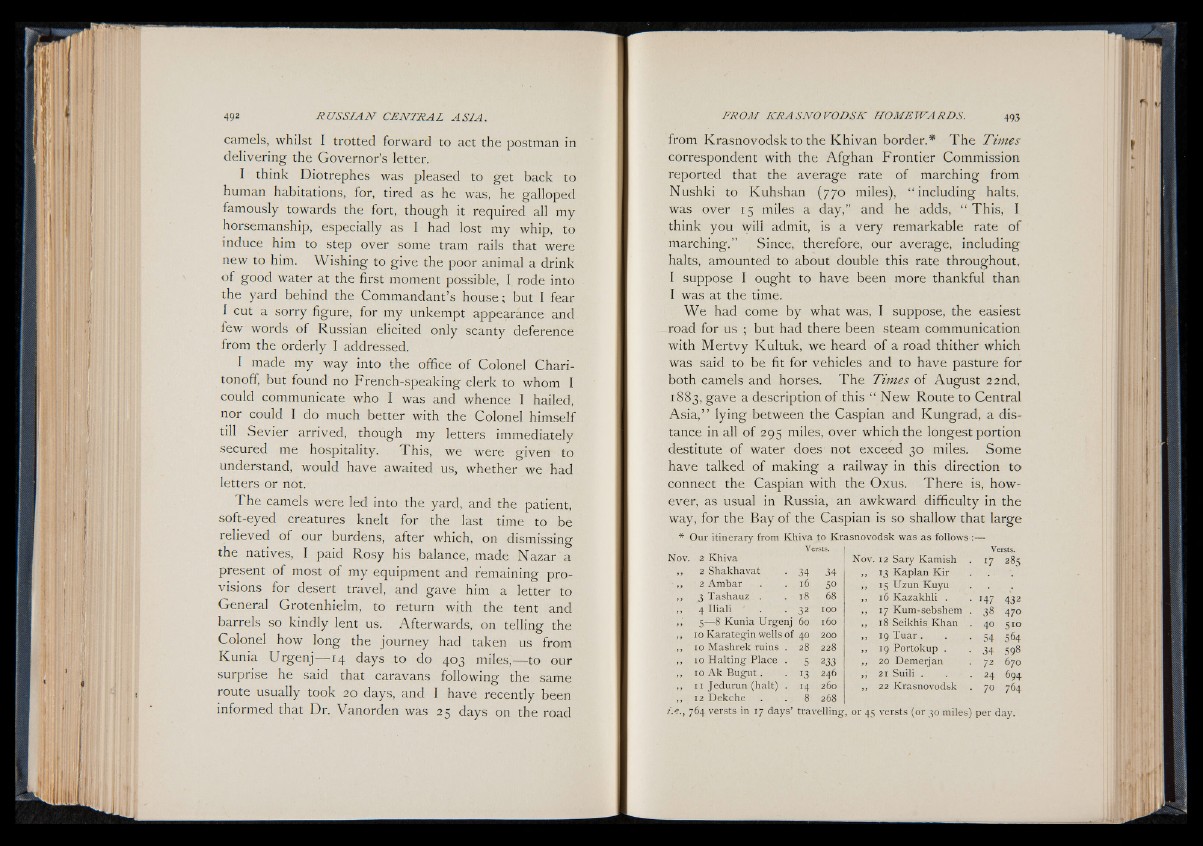
camels, whilst I trotted forward to act the postman in
delivering the Governor’s letter.
I think Diotrephes was pleased to get back to
human habitations, for, tired as he was, he galloped
famously towards the fort, though it required all my
horsemanship, especially as I had lost my whip, to
induce him to step over some tram rails that were
new to him. Wishing to give the poor animal a drink
o f good water at the first moment possible, I rode into
the yard behind the Commandant’s house; but I fear
I cut a sorry figure, for my unkempt appearance and
few words of Russian elicited only scanty deference
from the orderly I addressed.
I made my way into the office of Colonel Chari-
tonoff, but found no French-speaking clerk to whom I
could communicate who I was and whence I hailed,
nor could I do much better with the Colonel himself
till Sevier arrived, though my letters immediately
secured me hospitality. This, we were given to
understand, would have awaited us, whether we had
letters or not.
The camels were led into the yard, and the patient,
soft-eyed creatures knelt for the last time to be
relieved of our burdens, after which, on dismissing
the natives, I paid Rosy his balance, made Nazar a
present of most of my equipment and remaining provisions
for desert travel, and gave him a letter to
General Grotenhielm, to return with the tent and
barrels so kindly lent us. Afterwards, on telling the
Colonel how long the journey had taken us from
Kunia Urgenj— .14 days to do 403 miles,— to our
surprise he said that caravans following the same
route usually took 20 days, and I have recently been
informed that Dr. Vanorden was 25 days on the road
from Krasnovodsk to the Khivan border.* The Times
correspondent with the Afghan Frontier Commission
reported that the average rate of marching from
Nushki to Kuhshan (770 miles), “ including halts,
was over 15 miles a day,” and he adds, “ This, I
think you will admit, is a very remarkable rate o f
marching.” Since, therefore, our average, including
halts, amounted to about double this rate throughout,
I suppose I ought to have been more thankful than
I was at the time.
We had come by what was, I suppose, the easiest
road for us ; but had there been steam communication
with Mertvy Kultuk, we heard of a road thither which
was said to be fit for vehicles and to have pasture for
both camels and horses. The Times of August 22nd,
i883, gave a description of this “ New Route to Central
Asia,” lying between the Caspian and Kungrad, a distance
in all of 295 miles, over which the longest portion
destitute of water does1 not exceed 30 miles. Some
have talked of making a railway in this direction to
connect the Caspian with the Oxus. There is, however,
as usual in Russia, an awkward difficulty in the
way, for the Bay of the Caspian is so shallow that large
Our itinerary from Khiva to Krasnovodsk was as follows .
Versts. , Versts.
2 Khiva Nov. 12 Sary Kamish r7 285
2 Shakhavat 34 34 ,, 13 Kaplan Kir
2 Ambar 16 50 ,, 15 Uzun Kuyu
3 Tashauz . 18 68 ,, 16 Kazakhli . f47 432
4 Iliali ' . 32 100 ,, 17 Kum-sebshem 38 470
5-—8 Kunia Urgenj 60 160 ,, 18 Seikhis Khan 40 510
10 Karategin wells of 40 200 ,, 19 Tuar . 54 564
10 Mashrek ruins . 28 228 . ,, 19 Portokup . 34 598
10 Halting Place . 5 233 ,, 20 Demeijan 72 670
10 Ak Bugut, !3 246 21 Suili . 24 694
11 Jedurun (halt) . H 260 ,, 22 Krasnovodsk 70 764
12 Dekche 8 268
i.e., 764 versts in 17 days’ travelling, or 45 versts (or 30 miles) per day.